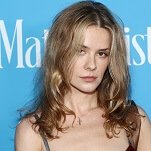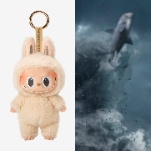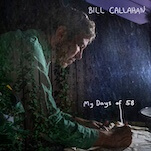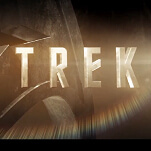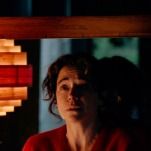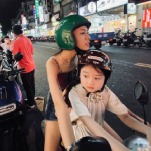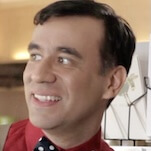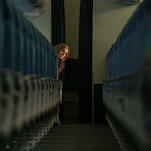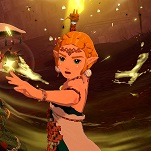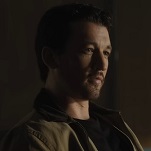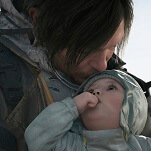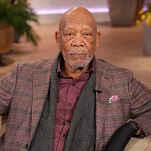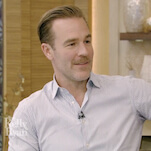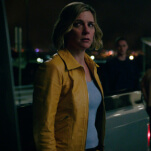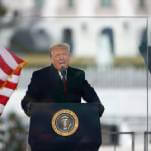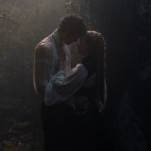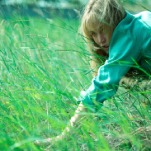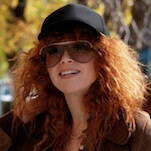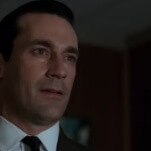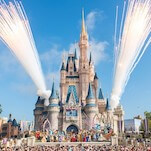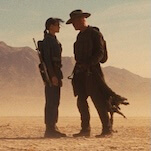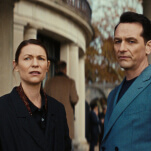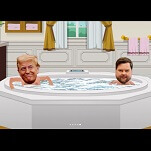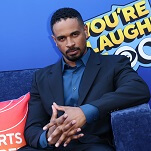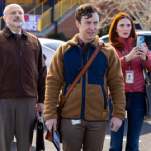Kevin Dunn on Veep, tracking Godzilla, and getting Gary Sinise’s hotel room
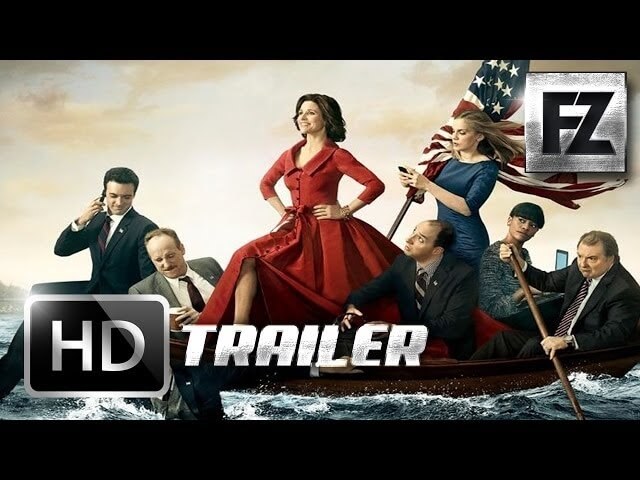
Welcome to Random Roles, wherein we talk to actors about the characters who defined their careers. The catch: They don’t know beforehand what roles we’ll ask them to talk about.
The actor: Kevin Dunn began his acting career in the Chicago theater scene, but after picking up a few small parts in movies and TV series that were filming in the city, he jumped in front of the camera on a full-time basis, leading him to pull roles in some high-profile sitcoms—among them Family Ties and Cheers—as well as some big-budget films, including Roland Emmerich’s Godzilla and, more recently, the first three Transformers movies. For the past few seasons, however, Dunn has become a staple on HBO: In addition to a recurring role on the short-lived Luck, he appeared in the first season of True Detective, and he continues to be a part of Veep, where he plays White House Chief Of Staff Ben Cafferty.
Veep (2013-present)—“Ben Cafferty”
The A.V. Club: Veep was already in the midst of its run when you joined the show. How did you find your way into the cast?
Kevin Dunn: Yeah, it was already up and running when they had an audition, and I think it was slated for a couple of roles. First I went in to read for Kent, Gary Cole’s role, which I didn’t feel right for. I’d seen both roles, and I read for Kent, but then I asked if I could also read for Ben. So I went back in and read for that, and the best part about it was that Julia [Louis-Dreyfus] was in the room. I did two episodes, and it turned into eight, and I guess they decided they’d like to see him as a regular character, so… there it is!
AVC: How much of the Ben’s character was there when you signed on, and how much was added once you landed the role?
KD: Well, I think they decided he was kind of a fun character to play with, being that we never see the president. So there’s that kind of liaison between the president’s office and Selina’s office, so it was kind of a nice conduit to have this guy around. The first episode, there was a lot to go on in terms of who Ben was. You know, they find him in a closet, lamenting. [Laughs.] So there was a lot of information, a lot of fuel, from the first couple of episodes to go on, and then they just kept writing bizarre stuff for him, so it was great.
AVC: Veep is a show that’s so well scripted and performed that it often seems more off the cuff than it probably is. How much improv actually goes on?
KD: Well, the writers do a great thing: They write a script, and it’s usually a pretty long script, 45 or 50 pages. Then we rehearse a lot, for a week or so, covering two or three episodes. We read through them, and then we put our scripts down and kind of improvise our way through the show, they take notes, and then they meet and they write again. So there’s a lot of writing and a lot of interaction with the writers, which is really nice, because there’s really no wall between us and them. They’re always there, and they’re always working, trying to perfect the script. So by the time you see it, it does look very improvisational, and that’s because they’ve let us improvise, they’ve gotten some things from that, and then they’ve tightened up the script further, so by the time it’s finished… [Hesitates.] I was going to say that they shoot a lot of footage, but I guess it’s not footage anymore. But anyway, they go through everything they get, and they boil it down to what you see.
AVC: Is there any particular moment with Ben that leaps to mind as something that came out of your own improvisation?
KD: Yeah, I was doing a scene with Julia in my office, where I was in another dazed and depressed state, and we started it with me just leaning against a window. And Julia—who’s just a brilliant improviser, of course—said, “This sounds like you’re on a shrink’s couch. Why don’t you just lie down on the couch?” So I did. [Laughs.] And it just kind of took on a life of its own after that. Everything just made sense.
AVC: The series has made a point of not having real political figures appear on the show, but have you actually heard from any political figures that are Veep fans?
KD: Yeah, we were in D.C. for the Correspondents Dinner, and we kind of got in there and hobnobbed with all the journalists and editors and politicians. They love the show. They really get a bang out of it. I think it’s partly because it really is hard to—You can’t put your finger on it and say, “Oh, this is about liberals.” Everybody’s sort of fair game, you know?
AVC: Have you met with any chiefs of staff to get a better feel for your role?
KD: No, I haven’t, although I was looking to see if David Axelrod was around when we were in D.C. for the dinner. He wasn’t. But, there’s just so much on the page that it’s almost—You don’t want to spoil it by asking for too much information from people who actually have that job, you know? [Laughs.] I’ve done it before, and sometimes it doesn’t work. I did it in a pilot for a show about homicide detectives, and it ended up the guy took me on a quadruple homicide, and it scared the living shit out of me. I had to go on this horrible murder scene in El Monte at a pool hall, so now I’m like, “All this business about researching your character sometimes doesn’t turn out very well.”
But we get a lot of government people there, and we have some really good advisors who work in Washington. We have Frank Rich, who’s just a goldmine of information, and our writers and Armando Iannucci, our creator, who spend a lot of time just boning up on D.C. So they do an incredible amount of research, and along the way you meet people and kind of get a good idea of who you are and where you stand. I’ve had several people come up to me at different parties claiming that they were Ben. I’m like, “I don’t know why you would be proud of that, but…” [Laughs.] “I mean, he’s a manic-depressive drunk, but… hey, that’s cool!”
L.A. Sheriff’s Homicide (2003)—“Lt. Bob Coughlan”
AVC: Just out of curiosity, what pilot were you working on when you visited that quadruple-homicide scene?
KD: It was called L.A. Sheriff’s Homicide, and it was written by James Ellroy and kind of sprang from his book My Dark Places. He went back and hired a detective who worked on the case when his mother was murdered, and then he just got really fascinated with this whole group of homicide detectives, so he wrote a pilot for this series. Ellroy, he’s quite a character. He’s a great writer. He was there the whole time, and it was really nice working with him. But it was very dark. It may have been a little too before its time, because it certainly was really good.
But my character was based on this lieutenant, and he said, “Ah, you’ll have to go out on a call with me sometime!” And I was like, “Yeah, sure okay!” So he called me at about 4 o’clock in the morning one day and said, “I got one for ya!” [Laughs.] So I drove down. He said, “Put this on and don’t say anything to anybody,” and we walked through the place. There were all of these pool tables, and then up top there was a ramp up, and there was a bar area that was kind of surrounded by a knee wall. So I walked up this ramp, and there were five or six people there who were investigating it. I didn’t really see anything until I got to the top of the ramp, but then just to my right was this kid with a hole in his head and his hand up in the air. I was just… I mean, I kept it together, but talk about your gallows humor. It was really, really hard to take. I didn’t really realize that, when those things happen, time freezes. Whenever you see a murder on TV or something, there’s people lying on the ground, and they’re kind of looking impassive. That’s not real. Everyone still has the horror that’s on their face at the moment that they died. And that’s something that I needed to know to play the part, I guess, and it was definitely something that I found out, but… wow.
Jack And Mike (1986)—“Anthony Kubecek”
AVC: Based on your IMDB listing, it appears that your first on-camera appearance was in the ABC drama Jack And Mike.
KD: Yeah, that’s correct. That was shot in Chicago. I was a cub reporter. Shelley Hack was one of the leads, and I was her assistant and a reporter for her. So that was my first foray into television: I’d pop my head in and say, “Commissioner on line five!” [Laughs.]
AVC: But apparently you got to say it in more than one episode. That’s more than most actors get for their first gig.
KD: Yeah! I think we did 13 episodes? And then we didn’t get a pickup.
AVC: How did you find your way into acting in the first place?
KD: I majored in theater in college. I did a couple of plays in high school, and I really enjoyed it, so I went to Illinois Wesleyan University and got a degree, and then I went back to Chicago and started doing theater in all the companies around the city for about 11 years before I moved out to L.A. I kind of knew what I wanted to do, but I had no idea how to do it.
AVC: You mentioned that Jack And Mike filmed in Chicago. Were you making a conscious effort to jump from the stage to in front of the camera, or was it just an opportunity that you took because it was there?
KD: It was there. It just came up. There were always movies and things that shot in Chicago, but it was kind of hard to get in the door, and this one I got in the door and got the role. It was such a shocking thing, though. I had no idea what the work was like. But I really enjoyed that whole idea of just creating a scene, there’s people all around, and you have to concentrate on what you’re doing, and then you finish it and you move on. It was a whole new thing.
Night Of Courage (1987)—“Policeman”
AVC: You’re at least the third Chicago actor who’s done Random Roles and played a policeman in one of his earliest gigs. It must be some sort of rite of passage.
KD: [Laughs.] Actually, that may be the first thing I ever actually did on film! I don’t know if I actually said anything or if it got cut out, but… what was it called? Night Of Courage? We went and hauled the murder victim out of the upstairs bedroom in the middle of the night. Good times.
Cheers (1987)—“Jim McNulty”
Family Ties (1988, 1989)—“Bob” / “Glen”
Day By Day (1988)—“Mel Schrom”
Seinfeld (1990)—“Joel”
AVC: Many people probably know that you worked with Julia Louis-Dreyfus in an early episode of Seinfeld, but you actually worked with her before that, on the sitcom Day By Day.
KD: Yeah! From Gary David Goldberg. That was a cute show. It was about a daycare center people ran from their home, and she was an obnoxious neighbor, I think? I can’t quite remember. But, yeah, I did four episodes of that.
AVC: And you’d worked with Goldberg just before that, doing an episode of Family Ties.
KD: Right. That was one of my first jobs in L.A., doing Family Ties. Yeah, he cast me a couple of times. He was a great guy, and he was really encouraging to me. He was one of those guys who’d go, “I saw you did this, and I saw you did that!” So you kind of felt that you were really in the game. He had a great energy. He was a great basketball player, too. [Laughs.] I did Cheers right around then, too, and Gary and Woody [Harrelson] and Ted Danson and a bunch of people used to play basketball outside of the Cheers studio on the Paramount lot. Gary used to be a point guard, and he still played like a point guard!
AVC: How was the experience of doing Cheers? That was a pretty high-profile series at the time.
KD: They were very welcoming, and, you know, they had it down. [Starts to laugh.] I, uh, just remembered we were playing basketball before the show, and I was all sweaty, so they told me to use Rhea Perlman’s shower… and she got a little pissed off. But I had no idea! She said, “Who took a shower in my shower?” But she was pretty sweet otherwise. They were all nice. They were in a position where everyone loved being on that show. It’s a lot like Veep, where you just get great actors coming in and doing roles, and you just have such a fun time as a result, whether it’s because of who the people are or because they’re so secure in what they’re doing. But it was a very nice experience. I played a mailman. I was a friend of Cliff’s, another mailman.
AVC: Just to circle back to Seinfeld, the episode you did was actually one of the very first of the series.
KD: Yeah, I think it may have been their second show. I was just like a million other guys at that point, all of us up for a role. But that was fun, too. I still have people come up to me and call me that character’s name. They’ll go, “Hey, Joel!” But half the time I can never remember the character’s name, so I go, “Uh, no, I’m not Joel.” [Laughs.] And then they rattle off a line from it, and they go, “I watched you on the show!”
Samantha Who? (2007-2009)—“Howard”
KD: Yeah, that was a nice show, a great cast. We still can’t figure out what happened. There was a writers’ strike, and we honored that, but we really thought we were just going to go ahead after that. But then it was kind of abruptly canceled after the second season. There were some great people on it, though: Melissa McCarthy, Jean Smart; Christina [Applegate] was great. It was a lot of fun doing that show. It was well constructed, and they had a lot of storylines that were really solid, so we were just kind of surprised when we got the sack. But you make good friends. I’m still good friends with Christina and Jean, and I keep in touch with Barry [Watson]. A lot of times you just move on and have good intentions, but you don’t actually keep up, so it’s good that we actually do.
AVC: Your sister [Nora Dunn] guest-starred on an episode of the show.
KD: Yeah, but we didn’t actually have a scene together. We did have lunch, though. [Laughs.]
AVC: Have you ever appeared on camera together? You’ve been in the same project a few other times—The Darwin Awards and Certifiably Jonathan—but now I’m gun-shy about being presumptuous.
KD: No, we never have! We used to do a little improv together sometimes in Chicago. I used to come up and do stuff with her, but, no, we’ve never gotten to work together on camera. Maybe someday!
Godzilla (1998)—“Colonel Hicks”
KD: Yeah, that was a big… [Hesitates.] Well, it was a lot of sitting on sets with a lot of navigational equipment and radar and saying things like, “He’s coming back this way!” [Laughs.] But like any of those films, it’s fun to be on them, because you get to see such technical stuff that you’d never otherwise get to see. The subway set that they built on the Sony lot was one of the most incredible sets I’ve ever seen. They have one stage that’s, like, eight stories high, and you walked up I don’t know how many hundreds of stairs… and that was the subway platform! You’d look out and see all of the destruction from where Godzilla went through the subway, from rail cars hanging off of tracks to mechanical flopping fish on the ground. It was just amazing and pretty incredible. Plus, I got to go to Hawaii, which was nice.
Mississippi Burning (1988)—“Agent Bird”
KD: That was my first film. Yeah, that was before they had video assist, I remember. My first night working, we went out to the country, and I had a scene with Gene Hackman and Willem Dafoe, and I was petrified. We were out in the middle of the woods with those huge lights, with the eerie shadows and everything. In the scene, we drive up, and we find a guy hanging from a tree, and we cut him down. Alan Parker, the director, was British, and he was telling me to pace forward, but I thought he was saying to face forward. So he said, “Bird! Pace forward!” And I turned my face toward the camera. “Bird! Pace forward! Pace forward!” And I kept turning my face toward the camera, going, “What the fuck is going on here?” And he kept yelling at me! And finally I said, “I don’t speak your English!” [Laughs.] And that scene kind of defused things a bit, and I felt a little better after that.
It was an incredible shoot, though. We were in Jackson and all around there, and then we went to Alabama and shot there. It was a great learning experience, because you were just around great people. Frannie McDormand was another one. And I just love Gene Hackman. He was up for an Academy Award for that, against Dustin [Hoffman] in Rain Man. But like I said, that was before video assist, so the crew—everything was just, like, “You got it?” “Yeah, we got it!” It was amazing. And I worked with that crew later on in a Ridley Scott film [1492: Conquest Of Paradise]. They did all the incredibly dangerous films, like The Mission and The Killing Fields, and they would go into the jungle or into the mountains or wherever it was and shoot a film. They were some great guys.
AVC: Regarding Gene Hackman, Kurtwood Smith said that he was great if you wanted to discuss technique or some other aspect of acting, but he wasn’t much for small talk.
KD: No, he’s one of those strong, silent types. But we had a lot of laughing fits on that film. I don’t know why. We had a scene where we’re driving around, and one of the kids has a bag on his head, and we’re looking for certain suspects, and… [Starts to laugh.] We’d just come around a corner, and we called it the Sidewalk Of The Stars, so we were just making up people, like, “There’s Buddy Hackett!” We just got into it, and we were in tears! “Oh, here’s Phyllis Diller up on the right!” I guess it’s long days or something. You don’t know why you’re laughing. But those are the kinds of things you remember: having these ridiculous moments in the middle of making this film, which was so serious and tense. It was fun. But it was a strange place down there. It was, what, ’87 or ’88? And yet people would just come up to you in a restaurant and say, “So, you workin’ on that nigger movie?” And it’s like, “Whoa!” I mean, how do you respond to that?
Snake Eyes (1998)—“Lou Logan”
KD: With Brian! I love Brian De Palma. I had worked with him on Bonfire [Of The Vanities], and he asked me to do Snake Eyes. I just remember the extremely long shots. We did a shot going up the stairs in the old—where the Montreal [Canadiens] used to play before they built the new ice hockey arena. And he’s trying to get this shot with the Steadicam where I’m following Nic Cage up the stairs, and there’s just a million things that could go wrong, so it took all day, but we finally got it.
A funny story about that film: Gary Sinise’s character in that was named Kevin Dunne. I said, “That’s a bad joke, Brian.” [Laughs.] But, anyway, I got to the airport, they whisked me off, and it was, like, “Oh, hello, Mr. Dunn!” And they drove me to this hotel, and it’s this beautiful old hotel. I was like, “Wow, I thought I’d be at the Marriott or something!” And I walked into the lobby, and they’re all like, “Hello, Mr. Dunn!” “Hi, Mr. Dunn!” And I go up, and it’s a penthouse suite, with a 30-foot circular living room and three bathrooms. I called my wife, and I said, “Wow, you’ve gotta come up here! This is incredible! I know they’re not paying me that well, I don’t know why they’d put me in this hotel room!” And then I got an abrupt phone call at 11 p.m., saying, “You’re not supposed to be there. That’s Gary Sinise’s suite.” So they came and, sure enough, they whisked me back to one of those Marriott-like places, and as I was leaving, all of the help was looking at me like, “Imposter! Get out!” But I didn’t put it together, you know? I just thought, “Wow, I guess everybody’s living like a king on this movie!”
Transformers (2007) / Transformers: Revenge Of The Fallen (2009) / Transformers: Dark Side Of The Moon (2011)—“Ron Witwicky”
KD: Yeah, that was quite an experience. I kind of got on that film because my manager kept calling Michael Bay’s office, saying, “Well, you know, this guy’s kind of a builder guy, and Kevin Dunn is a builder. He works on his house, and he’s renovated homes and stuff.” So he got me in the door, and I went and talked to Michael Bay. He took this place where he used to get his car painted and bought that building, so that’s his current office. He redid the whole place. Anyway, I read for it and got the role, and it really was fun, because he put a lot into our hands. The script was there, but it wasn’t… We’re lucky, because Shia [LaBoeouf]’s really good on his feet, and it was Julie White as the mom, and we really got to play around. He would say things like, “We’re not moving on ’til you make me laugh.” So we came up with a lot of stuff with the family that really made it worthwhile. You don’t expect that you’ll be doing a lot of improvising on a big high-tech robot movie, but we did.
AVC: It sounds like you had a bit more flexibility on the Transformers films than you did in your other big-budget extravaganza, Godzilla.
KD: Oh, absolutely. We just made them mildly dysfunctional and tried to ground it in some kind of reality. But we got a lot of good response from parents who took their kids to see the films. They’d be like, “Thank God! I thought I was just going to sleep through this movie, but you guys were really funny!” So that was cool.
Vicky Cristina Barcelona (2008)—“Mark”
KD: Oh, that was just so much fun. I guess we had sent some tape or a reel off to Woody Allen, and he just sent me a letter saying, “Would you read this? I’d like you to be in the film.” A courier comes and gives you some pages, and you read them, and then he whisks them away. I never really saw a script for it. He’d just give you an outline, and it would kind of tell you what your objective was. There was a lot of improvising in that scene, at least for what we did. I don’t know about the whole film. But it was just a great experience. My son and my wife came over to Barcelona. Woody works a very basic schedule. He plays his clarinet at night, you know? So it was, like, 8:30 to 5:30. A few nights, but it was just really pleasant! [Laughs.] We all hung out, and [co-producer] Helen Robin got us keys to the club room upstairs, so we would just go up there and clean the place out of food! It was a great experience and a great city!
Luck (2011-2012)—“Marcus”
KD: Wow. That was kind of a once-in-a-lifetime thing. It was funny when we were first asked to come to the read-through after all of the auditioning was done. The auditions took forever. I think it was about a month and a half, and you’d spend hours with Michael Mann, and he’d have guys in there with still cameras taking shots while you were auditioning, and you just kept coming back! And he’d say, “Would you come back and read with this person? Would you come back and read with so-and-so?” And I was like, “Yeah, you bet!” But we never really knew that we had the job. Then all of a sudden we’re gonna do a read-through! So we’re all sitting in a conference room, and they pass the scripts out, and then Nick Nolte says [Gruffly.] “’Scuse me, Michael, I got a question for ya.” And Michael says, “Yeah? What is it, Nick?” And Nick says, “Does this mean we got the job?” And everybody in the room burst out laughing, because there was no way of knowing if you had the job or not!
But, anyway, it was such a rare experience. I had never done anything like that, but I had auditioned for Deadwood, and I love David Milch. It was just this kind of odd poetry that he wove together, and you really had to kind of figure it out. It’s almost Shakespearean, in a way. But we just had a great time shooting it, and I thought the show was really powerful. It was really cinematic. I mean, we saw it at a premiere on a big screen, and I just wish everyone could have seen it that way. It was just an incredible cast, and it was incredible stories. But, you know, it was about thoroughbreds, and thoroughbreds are, uh, difficult to keep alive. [Laughs.]
We had great people working on it, but there was a lot of pressure just because there were horses in it. The reality of it, though, was that the whole medical board of the racing industry was so happy with our show because they implemented safety things that hadn’t been implemented elsewhere. So it really got a bad rap because, I don’t know, horse people are just so dedicated to their horses. They’re just like their children. You read the stories about horses being starved at Santa Anita, but a horse can’t starve at Santa Anita! I mean, there’s just bags of carrots all over the place, food is everywhere. They don’t starve any horses! And I guess TMZ ran a story about how cold our production was, because on the day the horse died, on the call sheet it said, “Make sure to get your picks for the NCAA playoffs in!” So it seemed like we didn’t care that a horse had died, but those are written a week in advance!
So it was just constant, and I don’t really know why it eventually was canceled. I’m sure that was part of it, but who knows? I was with Ritchie Coster, who plays Lorenzo and is just fantastic, and he finally decided that he was gonna get a place, so he got a place over in Silverlake. And I knew of a little furniture place up in Canoga Park that had just an amazing amount of chairs and tables for cheap, beautiful stuff. So we went up to Canoga Park, and it was right after the horse reared up after the first show [of the second season] on one of the grooms and fell on his head. I had a very bad feeling that day, so I called my agent, but they were, like, “Oh, no, don’t worry, everything’s fine,” blah blah blah. So me and Ritchie get up there, we got all the stuff, picked out a nice set of chairs and a nice table, and we were driving back… and we get a call from David and Michael saying, “That’s it. We’re done.” I was just so shocked that the only thing I thought of to say was, “Should I pull over and try to sell this table and these chairs for Ritchie?” [Laughs.] But, I mean, that was it. We’d shot the first episode of the second season, we were in the middle of the second episode, and that was it. It was just a sad day.
AVC: As long as you’re breaking hearts, just to jump back to something you mentioned offhandedly a minute ago, what role did you audition for on Deadwood that we never got to see you play?
KD: Oh, it was for E.B. Farnum. But William Sanderson was so perfect for it. I saw him at the audition, and I knew he was gonna get it. I was like, “Okay, well, I’ll at least go and say ‘hi’ to David. Good luck with the role!” [Laughs.] You couldn’t cast anyone else but him in it, you know? But good things happened after that. When something like that happens, you just have to get over the shock and move on.
Lost (2006)—“Gordy”
KD: Oh, that was odd. I did an episode there in Hawaii, and it was very involved. This character kind of took Josh [Holloway’s] character under his wing and ended up getting shot in this big shoot-out and everything, and all this stuff happened, but they never showed the episode! I never knew why. I never got any information. Then I went back and shot a different episode where I think I had, like, one scene where I saw him in a restaurant. But it was very interesting, because everybody thought they were gonna get killed off of that show. [Laughs.] Everybody was looking over their shoulder, going, “Jesus! Am I next?”
[Further research reveals that the first episode Dunn filmed for Lost was “Adrift,” but the Sawyer storyline of the episode ended up being dropped because, per Carlton Cuse in a Variety interview, “It just wasn’t properly conceived.” As for why it’s never turned up on any of the show’s home video releases, Cuse further explained, “We have no plans to put it on the DVDs because unlike most deleted scenes, which just don’t fit into the body of a particular show, this storyline was not at the quality bar we have for the show.” —ed.]
Hot Shots! (1991)—“Lt. Cmdr. James Block”
KD: Oh, my God, those guys were just so crazy. Lloyd Bridges was—I mean, I think he was 82 or something when he was doing that? And he was doing his own stunts! Once in a while, he’d walk on his line, and we’d all look at our watches… which, if you remember Sea Hunt, they’d all look at their watches when they were running out of time, and then they’d give a thumbs-up if it was okay and go, “Phew!” [Laughs.] But, yeah, that was a pretty wild film. We did a lot of improvising on that, too, but it was just sight gags galore, so you’d get wired up to look like you were getting the blood pumped right out of your body, you get pudding in the face… Every cheap trick in the book. There were some pilots there who had some old post-WWII jets that they flew around, and some of the guys got to go up in them, but I didn’t. I didn’t quite feel that I wanted to go up in a big, huge jet from 1957 or whatever, with the one big jet just under the fuselage. I said, “No, thanks, I’ll pass!”
Ghostbusters II (1989)—“Milton Angland”
Dave (1993)—“Alan Reed”
AVC: You worked with Ivan Reitman on two different films. Did doing Ghostbusters II have anything to do with getting Dave?
KD: Well, I doubt if it hurt. [Laughs.] I don’t think I auditioned for Ghostbusters II. I think I just went in and met [Ivan Reitman] on the set, he told me what the scene was going to be like, and I just went in and shot it in one day at Warner Bros., and that was it.
And then I got called in for Dave, where I went through a harrowing audition process. I mean, Dave was a long audition process. That went on for months. But I ended up with the job, and that was just a great experience because it was just such a great script, and there were so many great roles in it. There’s just not a lot of films that have that many great roles. You had Kevin [Kline] and Sigourney [Weaver], Ben Kingsley, Ving Rhames, Charles Grodin, Frank Langella… just all of these incredible characters packed into this film. And it stands up. We went to the 20th anniversary, and it stands up great.
We really didn’t spend much time in D.C. at all, though. We made some incredible sets on the Warner Bros. lot. They even made the Rose Garden and the White House! They built a big flat, basically, of the rotunda of the White House, and we took a crane up, and they did it at the arboretum in L.A. They flew the chopper in. We only went to shoot in D.C. for two weeks, but it was right when Clinton got elected first, so we spent Election Night with John McLaughlin. And it was kind of like the movie, because they all thought Clinton wasn’t going to win—we were with a lot of Republicans—but they just kind of petered out as the numbers came in. And then we went to the big party, and it was just a mob scene.
I was with Frank and Kevin and Sigourney and Ben, and no one knew who I was! So I just pretended to be Ben Kingsley’s bodyguard. [Laughs.] It was just easier to get through crowds that way. “Excuse me! Excuse me! Ben Kingsley coming through!” Because it was literally a mob scene. I’ve never seen anything like it. But we got to meet Tip O’Neil, and Chris Matthews was with us, too. There were a bunch of people in that film. And we went to a party at Ben Bradlee’s at one point. It was very surreal. I spent most of it just being a fly on the wall. “And who are you?” “Oh, don’t mind me. I’m just the bodyguard.”
The Beach Boys: An American Family (2000)—“Murry Wilson”
KD: That came in the day before they started shooting, because someone—whose name will remain anonymous—backed out. So I got the offer, and I didn’t really think it was going to be very good, but I got the script that night and read all four hours of it, and it blew me away, really. I thought it was a great script. I kind of scrambled to find this guy, but the most fortunate thing about that character was that there was a lot on audio of him in the studio with Brian and the Beach Boys. You could just listen to what a total asshole this guy was. I mean, he built them up and built them up and built them up, and he whipped them into being this rock ’n’ roll band, and then he just betrayed them, basically. He couldn’t handle their fame.
But, yeah, it was four hours, and we shot it in four weeks, so it was pretty exhausting. I thought it came out really well. You don’t see it much, though. I think the only place you ever see it is on VH-1. I think there’s still some lawsuits involved over it. I had no idea.
But Jeff Bleckner won a DGA Award on that, I think. And I had a blast. Once I got over the total horror of starting to prepare for something the day before it started filming, it just kind of fell into place. And all of the guys who played the Beach Boys were just great to work with. We just had a laugh riot doing it. There was a lot of humor filming it, because the scenes were kind of tense, so we goofed around a lot between scenes. You had to laugh about it to get through it sometimes, because Murry was just such an asshole. I remember my son, who was… oh, I don’t know, maybe 5 years old? He got to hide under the bed when Murry died of a heart attack. He was like, “I’m in the movie!” [Laughs.] “Yeah, while Dad has a heart attack up on top!”
The Second Civil War (1997)—“Jimmy Cannon”
Small Soldiers (1998)—“Stuart Abernathy”
KD: The Second Civil War was kind of an interesting HBO flick, and I thought Beau Bridges was great. Well, I thought the whole concept was pretty cool. I don’t know if it was… [Hesitates.] What was that other one along those lines? Canadian Bacon? Was that before or after The Second Civil War?
AVC: Slightly before.
KD: Okay, I wasn’t sure. I can never remember. [Laughs.] But, yeah, I thought it was kind of a cool concept, with things just totally going out of control…which is kind of where we are now, basically! You like to think that it could never happen, but it kind of is happening. But it was a fun character to play, that total Southern boy who’s just kind of protecting his president.
And with Small Soldiers, [Joe Dante] just called and offered it to me. It was fun, but it was a very hard shoot, because it was all of this very difficult technical stuff going on, with the little wars with these little creatures. But they weren’t actually animatronic. In fact, I just know some producer’s son ended up with some incredible toys after that film. [Laughs.] It would take two or three guys to operate one of these things, but they actually worked. It could wink at you, it could shake your hand, it could do whatever you needed it to do. Stan Winston had a huge semi, and they would just make all these things. They’d just keep making them. I don’t know how many they made. Some would only be from the waist up; some would be complete. But they weren’t CGI. They were real. I think the full-body ones cost something like $60,000 to make back then. They were all painted and silicon rubber, so every joint moved realistically, even their little hands.
AVC: Since he was in both films, even at the risk of sending everyone into a depression, it feels like a must-ask: How did you enjoy working with Phil Hartman?
KD: Oh, it was… [Sighs.] He was a great guy. I met him briefly before that, when my sister was on Saturday Night Live. He was a happy fella, I’ve got to say. He just kind of kept you in stitches the whole time. He could do a routine and never stop. But he wasn’t overbearing. He just loved to riff. I didn’t know him real well, but I really enjoyed working with him.
Marked For Death (1990)—“Lt. Sal Roselli”
KD: [Laughs.] That character just kind of disappeared! What happened was that I had been hired to do Dave, I think, when I got an offer on Marked For Death. And they said, “Oh, we’ll get you done in time, don’t worry.” Well, that never happened… and they were really angry, for some reason. I was like, “Well, you knew that I had this commitment already!” So that was just a character who all of a sudden just disappeared! “Hey, remember that guy? Whatever happened to him?”
The Bonfire Of The Vanities (1990)—“Tom Killian”
AVC: You mentioned it in passing a bit ago, but given the film’s reputation as a bit of a debacle, how was the experience of working on it for you?
KD: Well, you know, I guess I never knew how it went until it was finished. I was so happily oblivious. I just remember staying at the Regency and stinking up my hotel room because it cost, like, 10 dollars to wash a pair of shorts there. [Laughs.] But it was just a very long shoot. And all the courtroom stuff we did in Queens at night when I think it was, like, 100 degrees in New York, and everything was sealed. The windows were sealed because we had to have day for night, so they had to bounce light off of them.
Yeah, there was a lot going on that I wasn’t really privy to… or wanted to be privy to! But De Palma just kind of made the movie that he wanted to make. My character was based on Eddie Hayes, who was a big New York lawyer and player. I did meet quite a bit with him, and I, uh, don’t know if he was happy with the fact that I was cast, because of my stature. I mean, this guy’s really chiseled and played basketball for the New York Athletic Club up in Central Park South every day, and I was just this Chicago guy. [Laughs.] But it was fascinating just running around with him. We’d go to court; we’d go over to Brooklyn. He was a great guy—or is a great guy, I guess. I haven’t kept in touch with him. But everything and everyone was just huge on that film. I mean, you had Bruce Willis and Tom [Hanks]! I loved working with Tom. We got to play a lot. So, I don’t know, it turned out the way it did, but it wasn’t really the book, I don’t think. Films seldom are, you know?
True Detective (2014)—“Maj. Ken Quesada”
KD: I just thought it was an incredible series, incredibly done. I kind of went back and forth on that—I was shooting Veep at the time—but just being able to be in a room with Woody and Matthew [McConaughey] and do a good scene. That’s what I wanted. And the way it turned out, Nic Pizzolatto just wrote an amazing story. I don’t know if you’ve read a lot about Nic, but he was teaching, he’d written a few novels, and he was basically eating Spaghetti-O’s and stuff, and I guess somehow he went to a party and met a showrunner, and he was, like, “Wow! I want to do that!” And he just sat down and hammered the thing out! [Laughs.] I had all the episodes, even though I was only hired to do the first five out of the eight, but I didn’t read the last three, because I didn’t want to know how it ended.
That show is about as good as you can get, I think. I mean, it was riveting to me. I was looking at the cast list earlier, and these people… Everyone in that series was just kind of brilliant, you know? And the idea of having a show go with one director for all eight episodes really hasn’t been done much, I don’t think. But it seemed to work pretty well for them. I’m anxious to see what Nic comes up with for season two. I just remember that, when I went down, I was staying at some hotel in the warehouse district, and I went into my room… and the whole thing was just totally trashed! I was like, “What’s going on with my room?” [Laughs.] And they said, “Oh, well, uh, we’ll send somebody up to clean it up.” It was like a bunch of college kids had been there and just trashed the place. I guess maybe they climbed across the balcony and got in that way? I have no idea. But that’s New Orleans!
AVC: You’re kind of living the character actor’s dream, jumping from one critically acclaimed HBO series to another to still another.
KD: Yeah, for the last several years HBO’s really kept me—well, not just alive, but thriving! I just hope the love affair continues! [Laughs.]
GET A.V.CLUB RIGHT IN YOUR INBOX
Pop culture obsessives writing for the pop culture obsessed.

